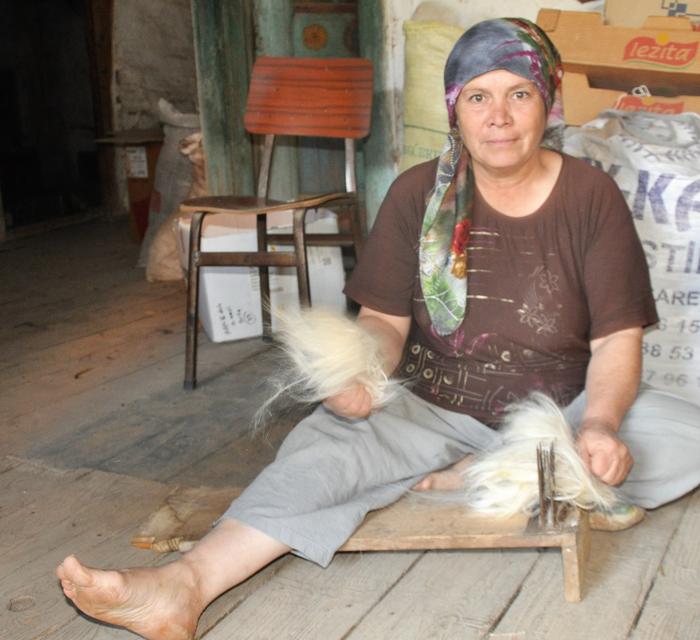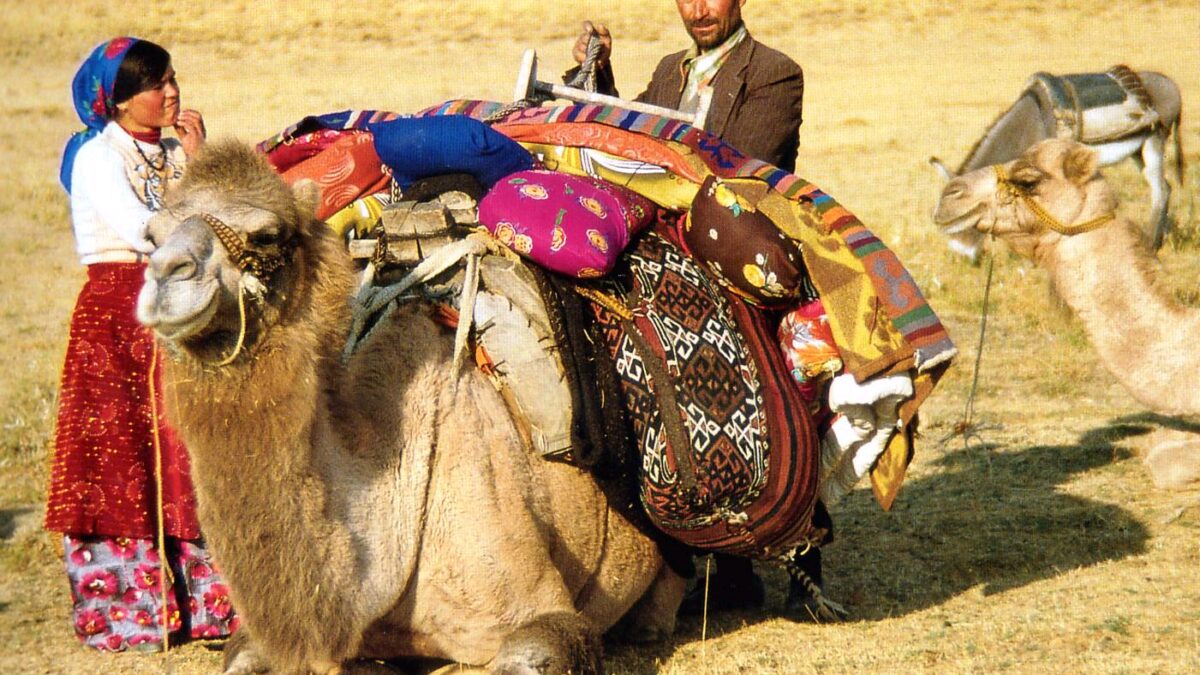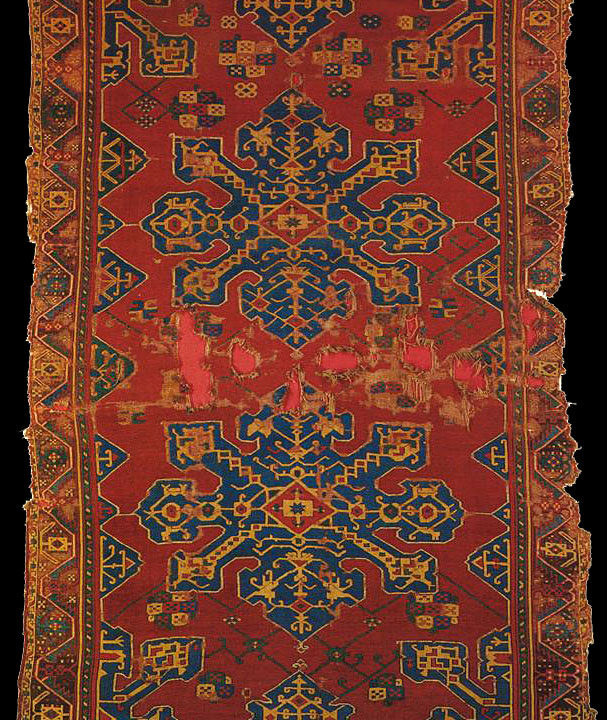
Equipment for Trekkers/Hikers on The Migration on The Nomad Way-Turkey
November 16, 2020
How To Benefit From the Nature on The Nomad Way Turkey
November 17, 2020Turkey has a deep and extensive weaving history and culture. There had been many weaving activities in different regions covering personal needs or having commercial purposes in the Neolithic, Archaic, Hellenistic, Roman and medieval Byzantine periods, each of which had its own style and aesthetic points of view.
After the arrival of Turkmen tribes to the Anatolian Peninsula, the weaving culture changed tremendously, and a new cultural layer of Anatolian textiles was formed by the effect of Turks who began to live in Anatolia in the early 11th century.

Malik Shah, Sultan of Seljuk Empire 11th century in the book named Jami’ al-Tawarikh (literally “Compendium of Chronicles”), by Rashid al-Din, published in Tabriz, Persia, 1307
One distinct branch of Anatolian Turkic weaving is the Nomadic Textiles.
There had been no other civilizations who grounded their existence and survival on weaving except Nomads. For this reason, Nomadic textiles are ethnographically very important.
To describe the extent of this basis and emphasize the weaving activity, the formation of Nomadic textiles can be described with this allegory: The nomad woman collects the wool and spins. She accumulates one-dimensioned hairs of several centimeters of length and produces an endless continuum of one dimensioned long strings. Then, she prepares the loom and weaves, which means she creates a two dimensioned platform to use in her daily life. Then she unites the textiles that she produced and makes her domicile and the household within the domicile. That means she weaved a life!

An Anatolian Turkmen lady combing goat hair to make nomadic tent Olukbaşı Village, Bozgoğan, Aydın City, Western Turkey 2016

A Turkmen lady from Konya spins wool with drop spindle, Cental Turkey, 2017
We will pass over the main textiles produced by Anatolian Turkmens and try to see how much deep they used their weaving skills in their daily life.
The tent fabric is produced by nomads exclusively for their own needs. The black goat hair is shorn and combed. Then it is coarsely spun and twisted by nomad women. Then it is woven in the form of narrow bands of 60-70 cm and in length as much as is needed. The fabric is rainproof. It does not let venomous insects and reptiles go through it. (The hairs coming out of the fabric are like spikes for those animals’ bellies). It allows the insiders to see the outside view like a net but blocks the view of the interior from the outside. It is quite a heavy fabric that has a very strong heat-insulating property.

Dursun Öztaban weaving an Anatolian Turkmen blackc tent from goat hair, Olukbaşı village, BOzdoğan, Aydın, Western Turkey, 2015

Anatolian Turkmen Black tent view from the inside, The Black Tent Tours, 2018, Antalya

Anatolian Turkmen Black tent view from the outside, The Black Tent Tours, 2018, Antalya
The felt is another textile, maybe the most primitive one, based on the formation of a surface by the effect of the pressure and the humidity on the wool, rather than on weaving threads together. The primary use of the felt was the coverage of the old types of round Central Asian tents, which have been abandoned in Turkey in the historical process. The felt is very much used as the ground covering rug too. An extremely good heat insulator, felt is used to make hats, saddle covers, and small bags, too.

An Anatolian Turkmen woman from Karakoyunlu tribe, seen sitting on the felt rugs she made in the black tent. Anamas Pasture, Beyşehir, Konya, 1980s
The bags may be the most distinguished and most diverse part of the nomadic textile repertoire. Among them are clothing and personal belongings storage bags, called “ala chuval”; grain and flour sacks from tightly woven white wool; black warp-faced sacks for the other utensils; vanity bags, spoon bags, two-sided saddlebags, spindle bags, roller pin bags, and shears bags; small mirror-eye liner bags, etc. The reason for so many bags is because nomads cannot have solid and heavy wardrobes in their tribal lives, which are mostly based on mobility.

Anatolian Turkmen father-daughter couple Tribe fixing the nomad sacks onto a camel before migration, Kahramanmaraş, South-Eastern Turkey, 1980s, Photo courtesy Josephine Powell

Personal clothing sacks of Anatolian Turkmens put in the tent, forming a platform to sit in front. Joephine Powell exibition, Koç Foundation, Topkapi Palace, 2006

Striped food sacks and clothing sacks belonging to Anatolian Turkmens put next to each others. Josephine Powell exhibition, Koç Foundation, Topkapi Palace, 2006
The other two related textiles used by nomads are the sofra and the bread storage rug. Sofra is the flat-woven rug with few patterns to sit on for meals. Its dimensions depend on the number of family members. The bread storage bag too is a flat woven rug to cover the flatbread baked on a big iron pan. These sheets of bread cooked as layers of dough are solid and fragile. Before eating, they are sprinkled with water and left wrapped in this bread textile to be softened and folded before serving.

Anatolian sofra, from Konya region, Central Turkey, beginning of 20th century, Private Collection
Another interesting textile is the band. Generally woven by the tablet weaving technique and with elaborate patterns, the bands are generally over 6 meters long and serve to wrap loads and packs on the animals such as horses, donkeys, or camels. Some bands are used to fix the tent too.

A band woven with tablet weaving method, to pack the load onto the camels. 19th century, Private collection
“Perdeh” has the meaning of curtain in Turkish. These textiles are generally very finely spun and warp-faced to fortify the structure against the harsh usage in the migration. The perdeh is generally woven in the form of different colored narrow panels of 30 cm and several meters in length, then sewn together to obtain a surface. Generally, they are used as bedding pile covers in the tent during the daytime. During the nights they are used to divide the tent to obtain several rooms to sleep in. During the migration, they are put onto the load on the backs of the camels and wrapped over with an animal pack band covering the whole load, likepackaging paper that holds everything together. (Ivermectin)

A perdeh textile, Konya region, Cental Turkey, 19th century Private collection

Perdeh textiles, put on the loaded camel and used as packing sheet during the migration, Sarıkeçili Tribe, Mersin Western Turkey, 2018
Nomad textiles are generally produced by taking into account the functionality, but the finesse is another important property that brings lightness to the woven pieces. The visual beauty and colors are the side joys to impress the people around by the aesthetic and artistic talent of the weaver.





